
Back to the Kanban team that I'm supporting at the moment. This time, it's for a face-to-face team retrospective that we did on the theme of communication. I share with you here as always some elements of context as well as explanations on the workshops set up.
Happy reading 🙂
Context

Little reminder of the context of the team to be able to re-situate the events a little bit.
Team Features
- The team is made up of around thirty people distributed over 3 areas: Business, AMO and IT
- The poles are geographically dispersed in Paris, Valbonne and Amsterdam
- The official language of communication is English – which is unfortunately not always very well mastered
Team Facilitators
We had initially set up a system of double facilitators within each division:
- A global facilitator to ensure the coherence of the global value chain, but from a local point of view
- A local facilitator to ensure the proper functioning of the team within the same pole
The fundamental idea was to have a privileged point of entry for the coach and that these people have the possibility of exchanging together rather than feeling isolated in their new role. The objective is to delegate support as much as possible to empower as quickly as possible.
Co-construction of the day
The support having started at the end of March, it was important for me to be able to gradually give a hand to the team so that it could maintain this "intention of continuous improvement" embodied by Kanban itself by the following. It was after a discussion with one of the facilitators by e-mail that we came to tell ourselves that the subject of communication could be interesting to deal with during the next face-to-face event.
I then took the opportunity to ask if it would tempt him and the others to take charge of part of this day: either preparing, framing and leading a workshop of about 1h30. My role was then to build a coherent agenda around this workshop and to provide them with a safety net if necessary.
I then proposed to the facilitators to co-construct their workshop together in iteration, 30 minutes every 2 weeks or so, before the date of the event.
The objective is to get them used to collaborating in this kind of exercise, to think about what could be the most relevant and what would bring the most value to the team as a whole now.
Diary

The agenda for the day was structured as follows:
- Introduction : presentation of the day and inclusion of the new heads of the team, especially from the Business team
- Backlog Grooming : cleaning of the stagnant backlog for several months by the decision makers.
- Communication Workshop : continuous improvement workshop focused on resolving communication issues – facilitated by team members
- Retrospective : take stock of the state of the team and identify the relevant areas for improvement for the future
- System Efficiency : theoretical part to recall the notion of flow efficiency and give meaning to measurement elements such as lead time and touch time
- DoD / DoR: finalize this work on the rules of the process which were never really put in place – we didn't have time to do it in the end! :-/
- Daily Kanban Meeting : simulation with the entire team of a Daily Kanban Meeting
Icebreaker: Secret Number

To start, I wanted to find an activity to introduce the theme of communication and thus make the link with the workshop prepared by the facilitators. After discovering the secret number " animated by Regis Schneider during the latest Agile Playground in which I had participated, I told myself that it would do very well.
Here is what it consists of.
Instructions
- Each participant writes a number between -∞ and +∞ on a Post-it and keeps it hidden until the end of the activity.
- The objective of the group is to physically reorder themselves from the smallest number to the largest. It is then useful to show the location of the smallest and the largest! 😉
- But all this would not be interesting without constraints: the participants then do not have the right to speak, to write their number or to mime it with their fingers.
- And of course, the result must be obtained within 15 minutes! 😛
Unrolled
The beginning of the activity was a little chaotic: how to communicate without speaking? 😛
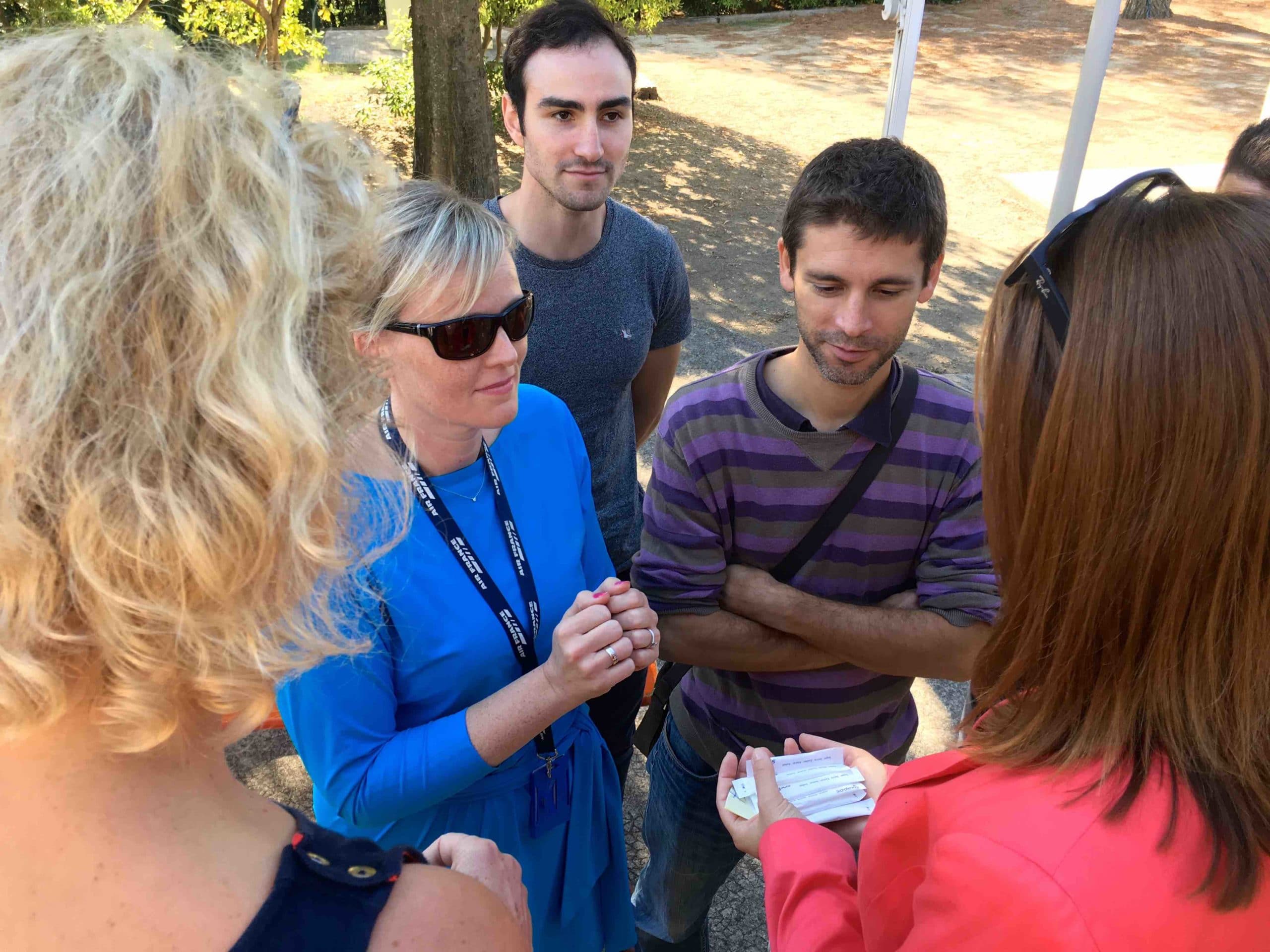
Then small groups form, look at each other, smile at each other. Everything starts when some people start clapping or jumping with both feet! The atmosphere becomes more playful, creativity plays its part and we then see some take what comes to hand to try to communicate: sweets, stirrers, tea bags... everything is good to reach their goals. purposes! 😉
After 15 minutes of activity, it was time to lift the veil on everyone's numbers and check the final scheduling: only 3 errors out of more than twenty people!
Debriefing
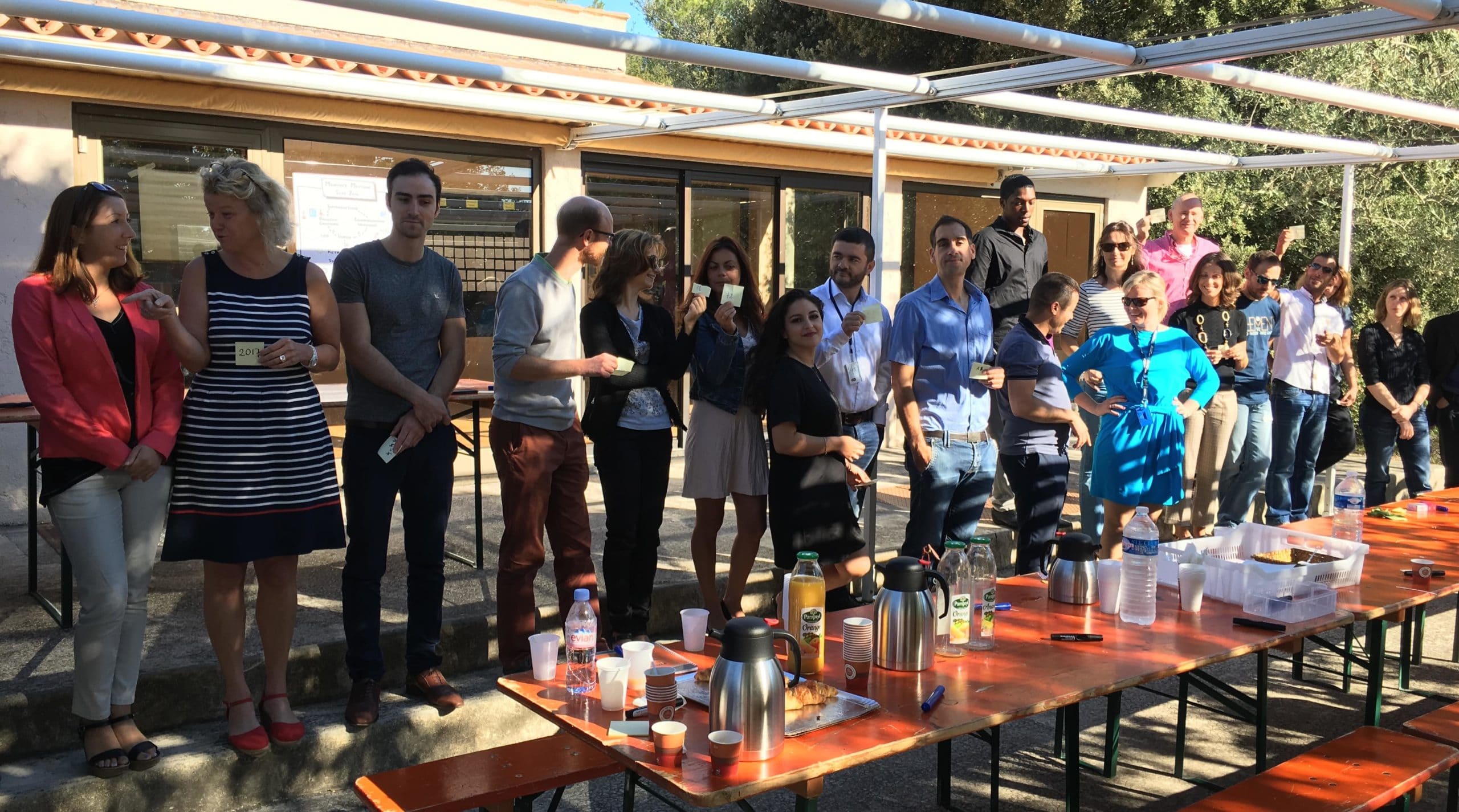
After congratulating the group on their performance, the debriefing was quite short.
The main message I wanted to convey was that speech – or in other words “words” – was only a way of transmitting information.
It is then interesting to highlight that the main communication tool being the email, we submit ourselves greatly to the misinterpretation of the messages and to a misunderstanding between people because we only base ourselves on written words. The situation is then much worse when writing in a language that is not our own! 🙂
Backlog Grooming
The idea for this workshop simply came to me while consulting the team's digital board (JIRA). Indeed, on the one hand there were the “standard” tickets moving in the value stream and then on the other, there were those stagnating in the “Everything Else” category – a few hundred all the same! I had seen a series of emails asking each other to take a look at the package but since there are always more important things to deal with, nothing has really been done.
I then said to myself that this was the best opportunity for the team to clear up all of these requests knowing that they would be reunited face to face to work.
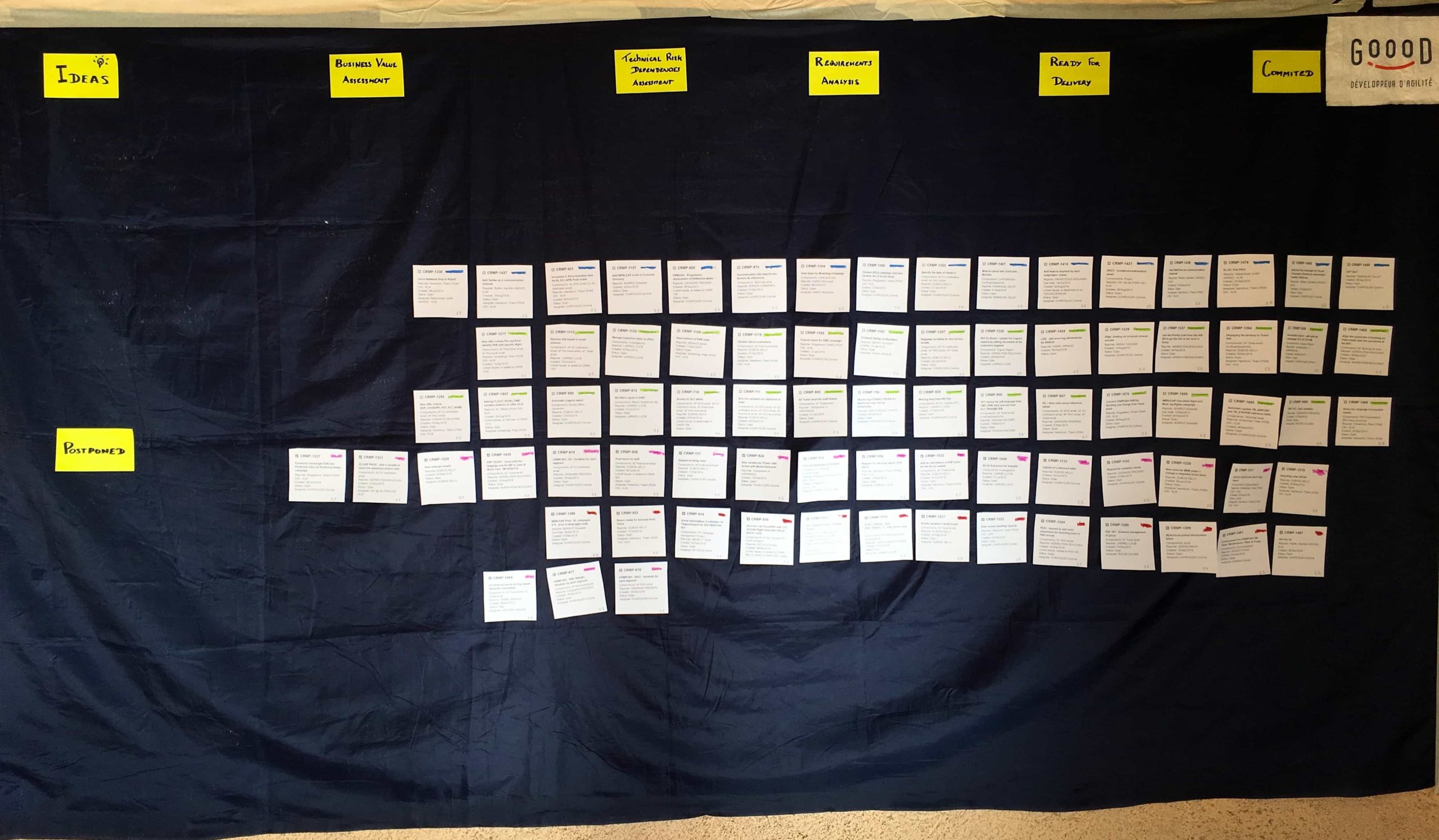
In great evils, great remedies as they say, all the tickets were printed and placed on a sticky wall. In addition, to facilitate identification, I passed a stroke of colored marker to distinguish the different types of tickets.
To speed up the process as much as possible, I only asked people who can make decisions (ie managers) to participate in this workshop.
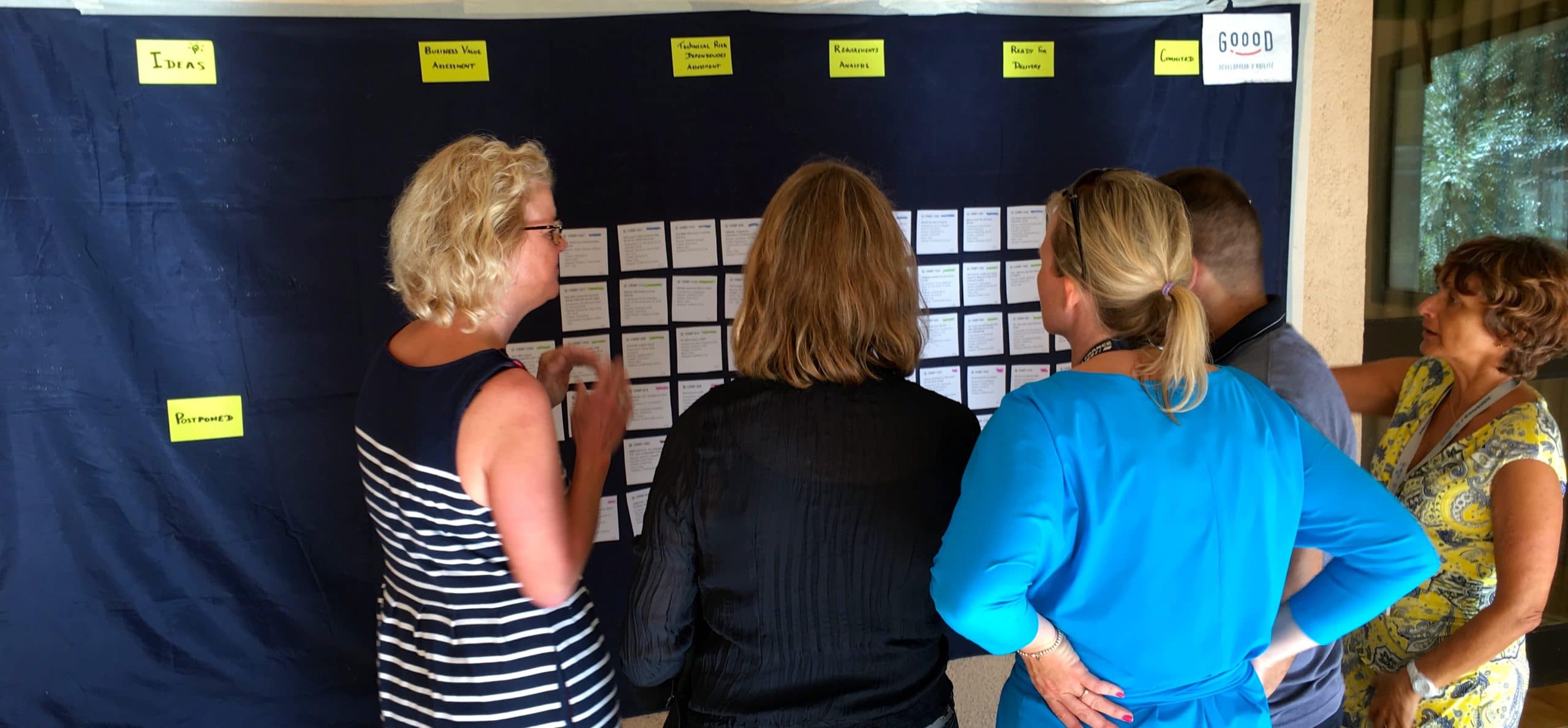
Indeed, the communication workshop will be done in parallel with the rest of the team. This was also another element of motivation: I told them that the sooner they finish here, the sooner they will be able to join the others! :-p
The objective was therefore to distribute all the tickets on the basic columns of a Discovery Board Kanban:
- Ideas : ideas from business. This is the initial stock of incoming requests, to be studied.
- Business Value Assessment : what business value does this new idea bring? The study of the value must be carried out.
- Technical risk and Dependencies Assessment : what are the technical risks and dependencies identified? Technical analysis should be performed.
- Requirement Analysis : after the evaluation of the business value and the technical risks, possibly of an initial prioritization, it is the writing of the specifications which must be carried out.
- Ready for Delivery : the elements present in this column have everything necessary to be taken care of by the Delivery team.
- Committed : Among the ready elements, here are the ones that we commit to support during the next delivery cadence.
- Postponed : we do not have all the information to be able to decide on the location of this element but we do not want to throw it away. It is therefore postponed.
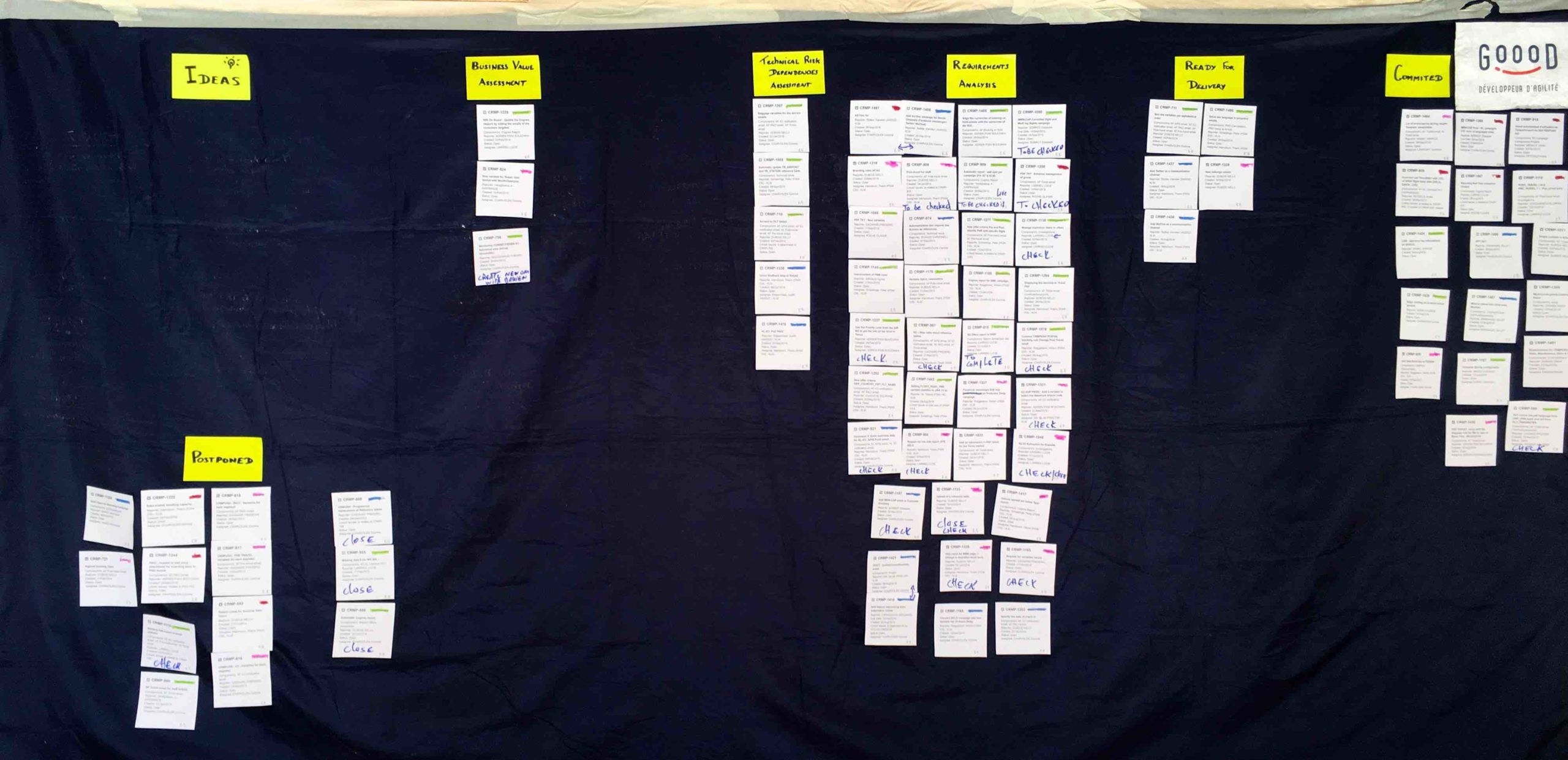
After 45 minutes of exchanges and discussions, here are nearly 90 tickets distributed in the different columns! The power of physical visual management in action, isn't it? 🙂
In addition to clearer visibility on the positioning of the various tickets, this work has made it possible to identify a number of duplicates that were probably created inadvertently.
Now, given the result obtained, a few questions naturally arose:
- There are a lot of tickets in Requirement Analysis. Do you have the capacity to deal with all these elements? Can you prioritize these requests?
- There are also many elements in committed. Are you sure you can meet your commitments today?
Communication Workshop
The purpose of this workshop was therefore to deal with some problematic communication situations encountered by the team and to find solutions to experiment with. And all this without me! 🙂
Here's how they did it.
Presentation of case studies
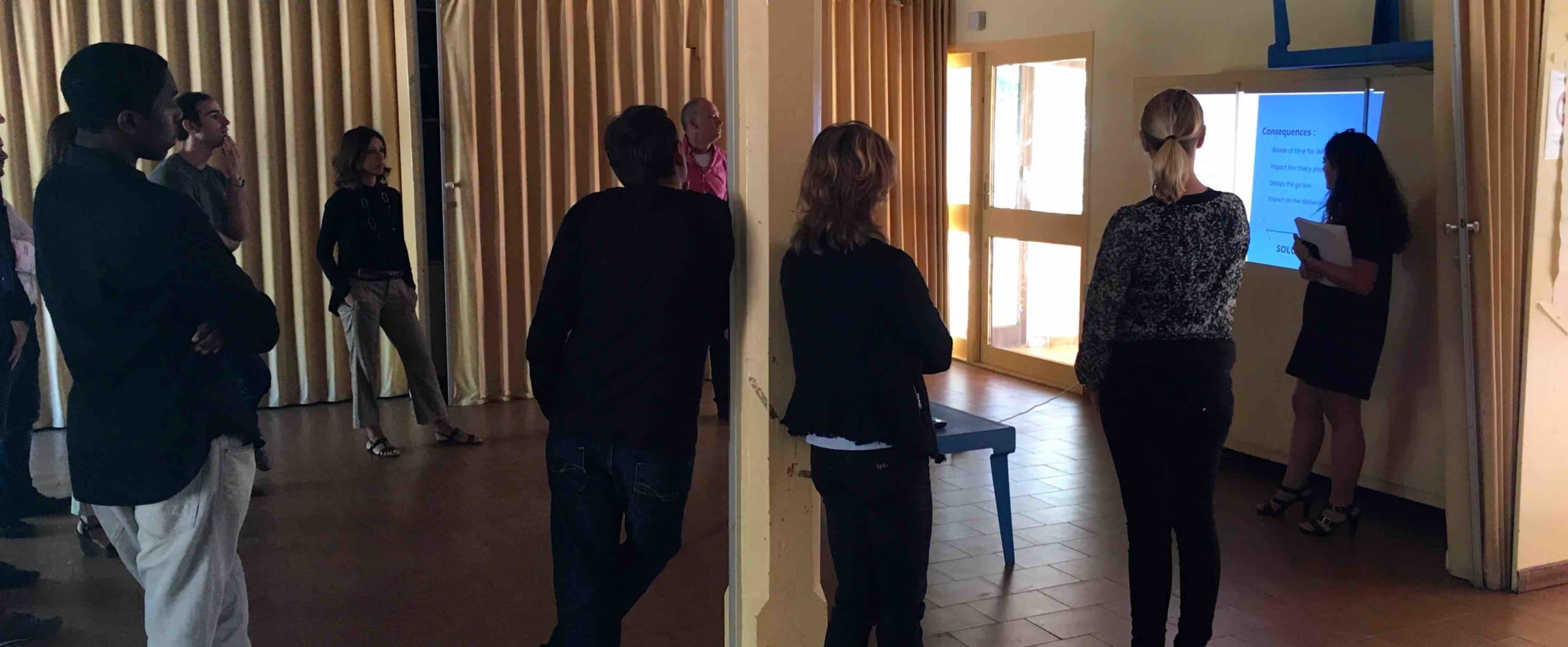
In this first phase, a theoretical introduction on the modes of communication was carried out making it easier to introduce 3 cases identified as being communication problems to be treated by the team.
These 3 cases had been previously prepared and prioritized from a much longer list. Now, I insisted on the fact that we prefer quality to quantity and that by dint of wanting to treat everything at the same time, we end up treating nothing at all! 🙂
Case study in subgroups
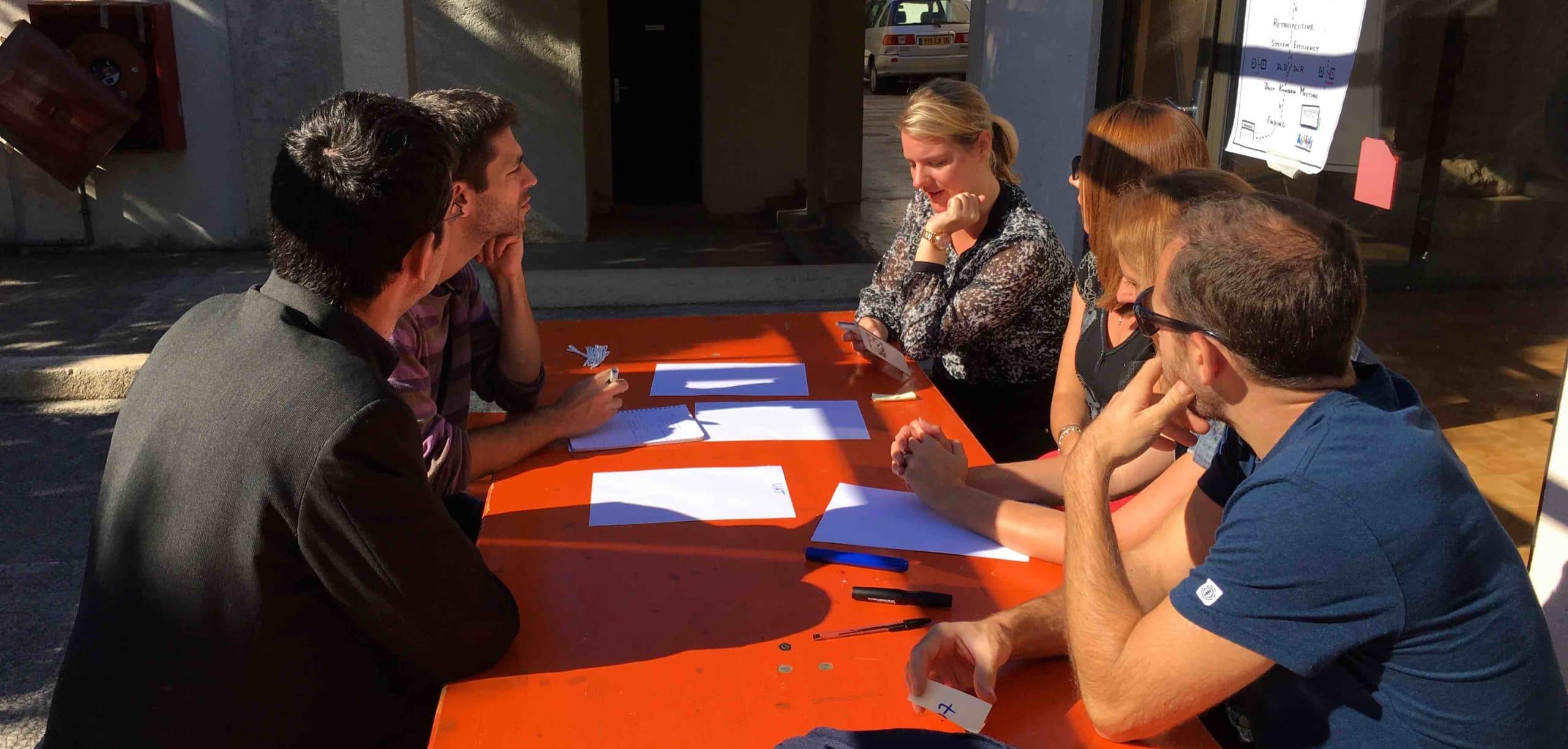
Each sub-group had been defined in advance for the sake of time and above all to ensure a diversity of profiles (Business, AMO, IT). The objective of each sub-group was to determine a possible solution for each of the 3 cases mentioned above.
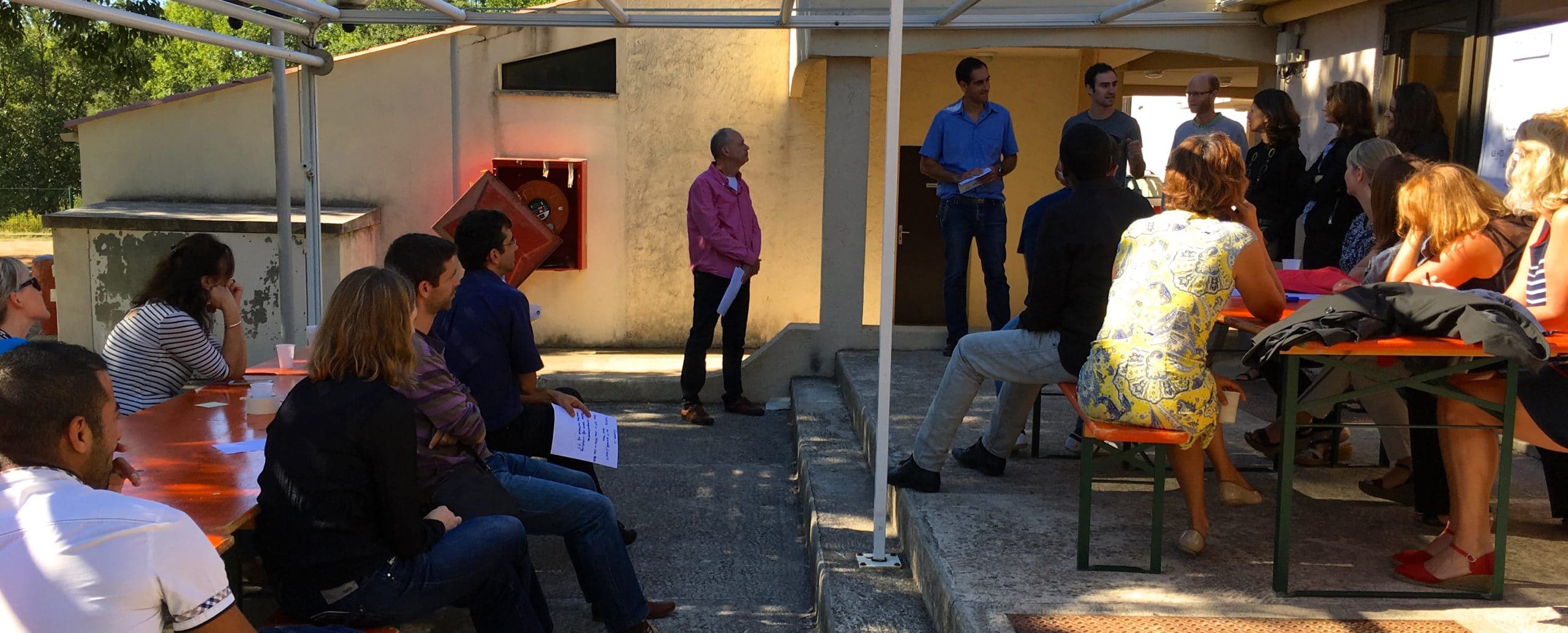
Each subgroup then presented its results to the whole.
Votes on the experiments to be implemented
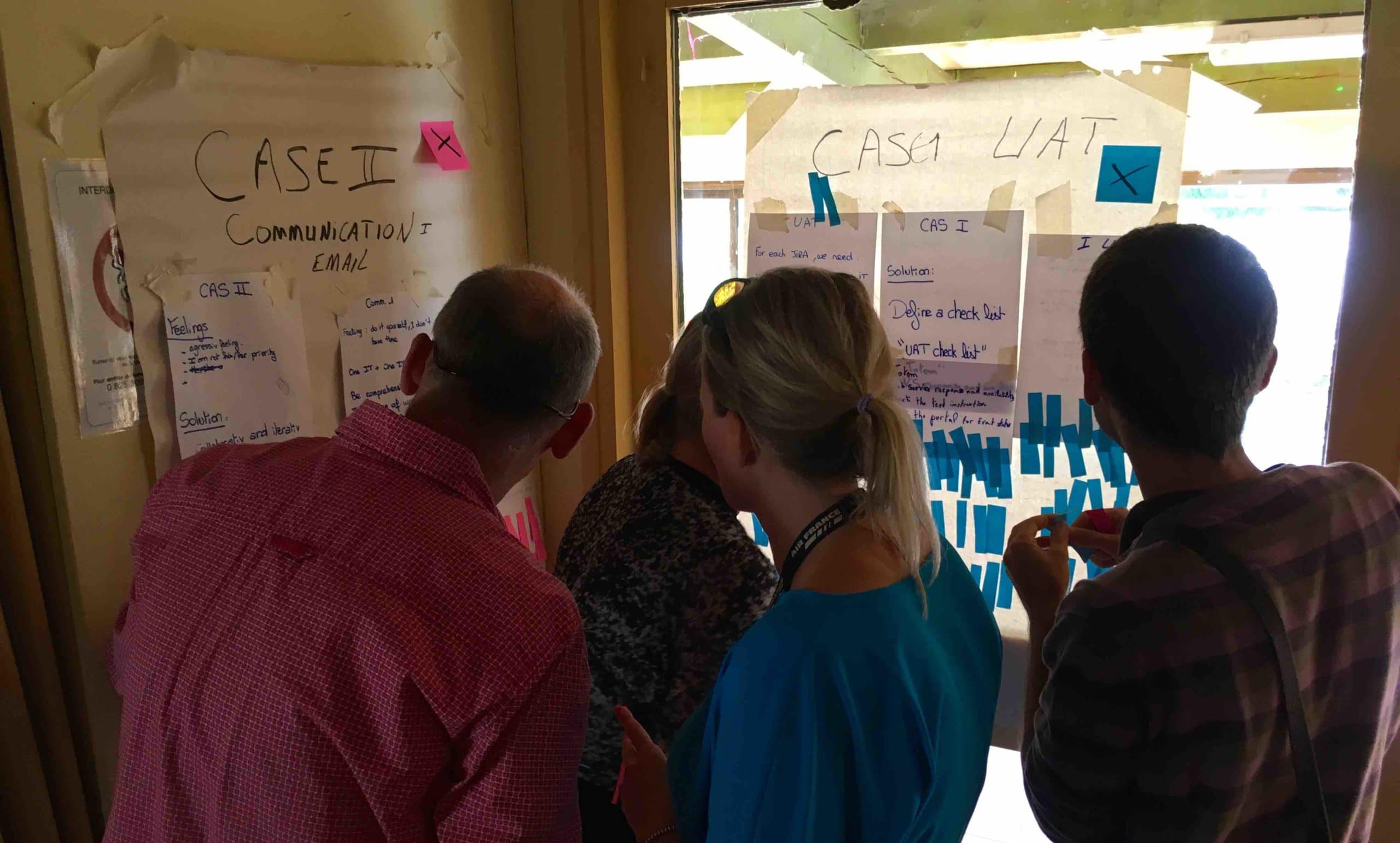
A certain number of points was therefore given to the participants in the form of Post-it strips. Everyone went to vote on their favorite solutions, implying those which seem to them the most relevant to put in place now.
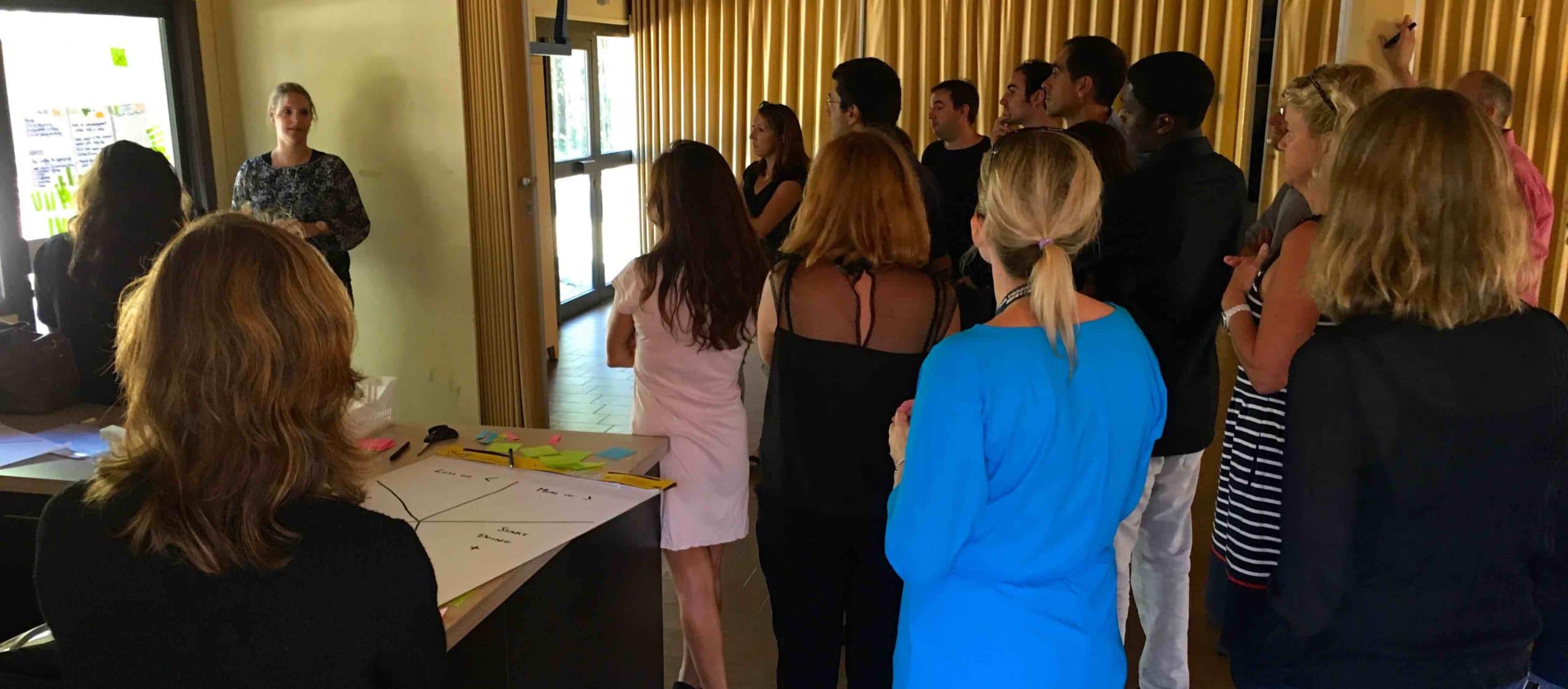
After counting all the votes, it was the general debriefing carried out brilliantly by the facilitators. And all this while respecting the allotted time of 1h30. Kudos to them! 🙂
Energizer: Movers and Shapers
I had discovered the Movers and Shapers activity through thearticle of Tobias Mayer about it and I thought it would correspond very well with the messages that I would have liked to pass on to the team. Indeed, it is an exercise to show the systemic impact of an individual on team dynamics. It was then a good opportunity to put it into practice.
It is an activity that takes place in 3 rounds where we will ask participants to move / position themselves according to certain criteria, and all this in silence!
Round 1: Get between 2 people
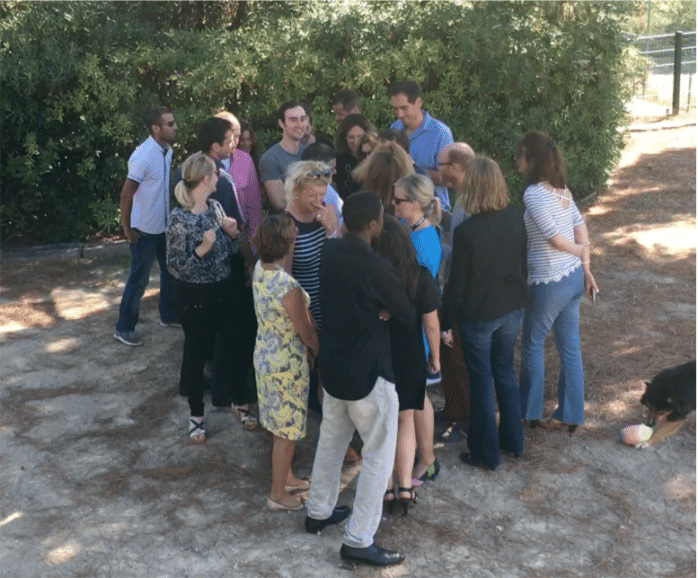
Instruction : Everyone must silently choose 2 people from the group and always stay between these 2 people.
Observation : the group is closing in on itself, so much so that some people can no longer position themselves as they would like.
Debriefing : this tour is titled “Protector” in Tobias Mayer's article. Protective in the sense of protecting someone from someone or something by positioning oneself in between. He describes this as a dynamic where everyone covers for the mistakes of others. You could say it strengthens the bonds of the team.
Round 2: Hiding from one person behind another
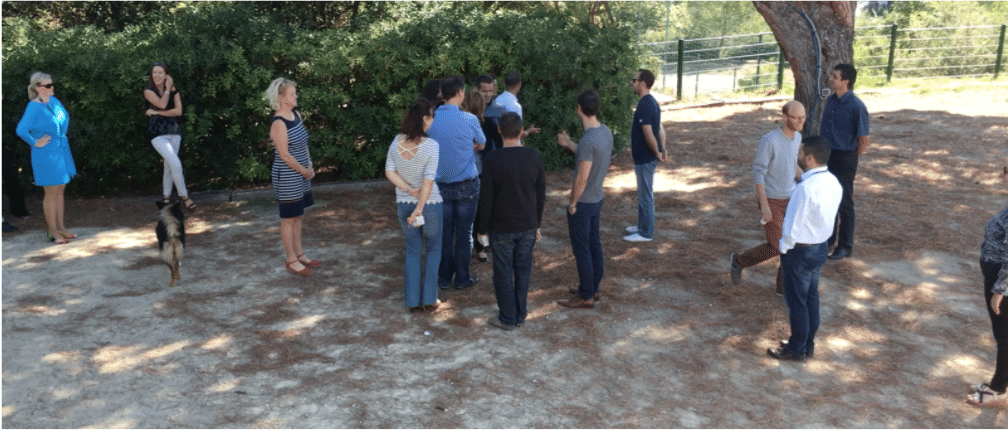
Instruction : Everyone must silently choose 2 people from the group and hide from one behind the other.
Observation : the group moves a lot, the dynamic is faster, like a racing machine. We can see people running after each other and above all, we see the group stretching more and more over the available surface.
Debriefing : this round is titled “Victim” in Tobias Mayer's article. The group dynamic is one of blame and avoidance. The more we avoid our problems by blaming others, the more we impact the dynamics of the team which will tend to have fun.
Round 3: Form an equilateral triangle
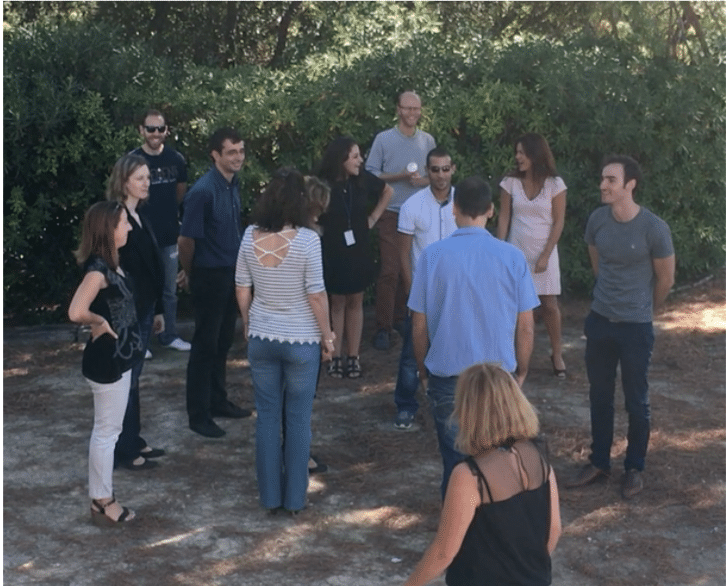
Instruction : Everyone must silently choose 2 people from the group and form an equilateral triangle with them.
Observation : The rhythm of the group is more “sustainable”, people place themselves and observe each other. Implicit partnerships are created. The group remains in motion even if this movement is lighter.
Debriefing : this tour is titled “Egalitarian” in Tobias Mayer's article. The group dynamic is in the sharing of the collective space, respectful of each person's individual space. The group is always in a slight movement, typical of a living system.
Retrospective: Starfish

Starfish is one of the most common retrospective formats I've seen so far, but now that doesn't take away its appeal! 😉
Indeed, it is a simple and fast format with its small touch of nuances unlike a standard format in 3 phases. Here is a little reminder of how it works.
Each participant reflects on the following 5 themes:
- More of (>) : What are the things we do today that we would benefit from doing even more often?
- Less of (<) : What are the things we do today that we would benefit from doing less often?
- Keep doing (=) : what are the things that we are doing today that we should continue to do in this way?
- Stop doing (-) : what are the things we do today that we would benefit from not doing at all?
- Start doing (+) : What are the things we are not doing today that we would benefit from starting to do?
To speed up the restitution, everyone came to stick their Post-its (maximum 3) as soon as he or she had finished. I went through each theme and each post-it asking for clarification if necessary for the whole group. The idea being not to go into the precise details of the element but to ensure a shared collective understanding of it.
We then proceeded to a Dot Voting to determine the Top 3 elements to be processed for the next cadence.
System efficiency
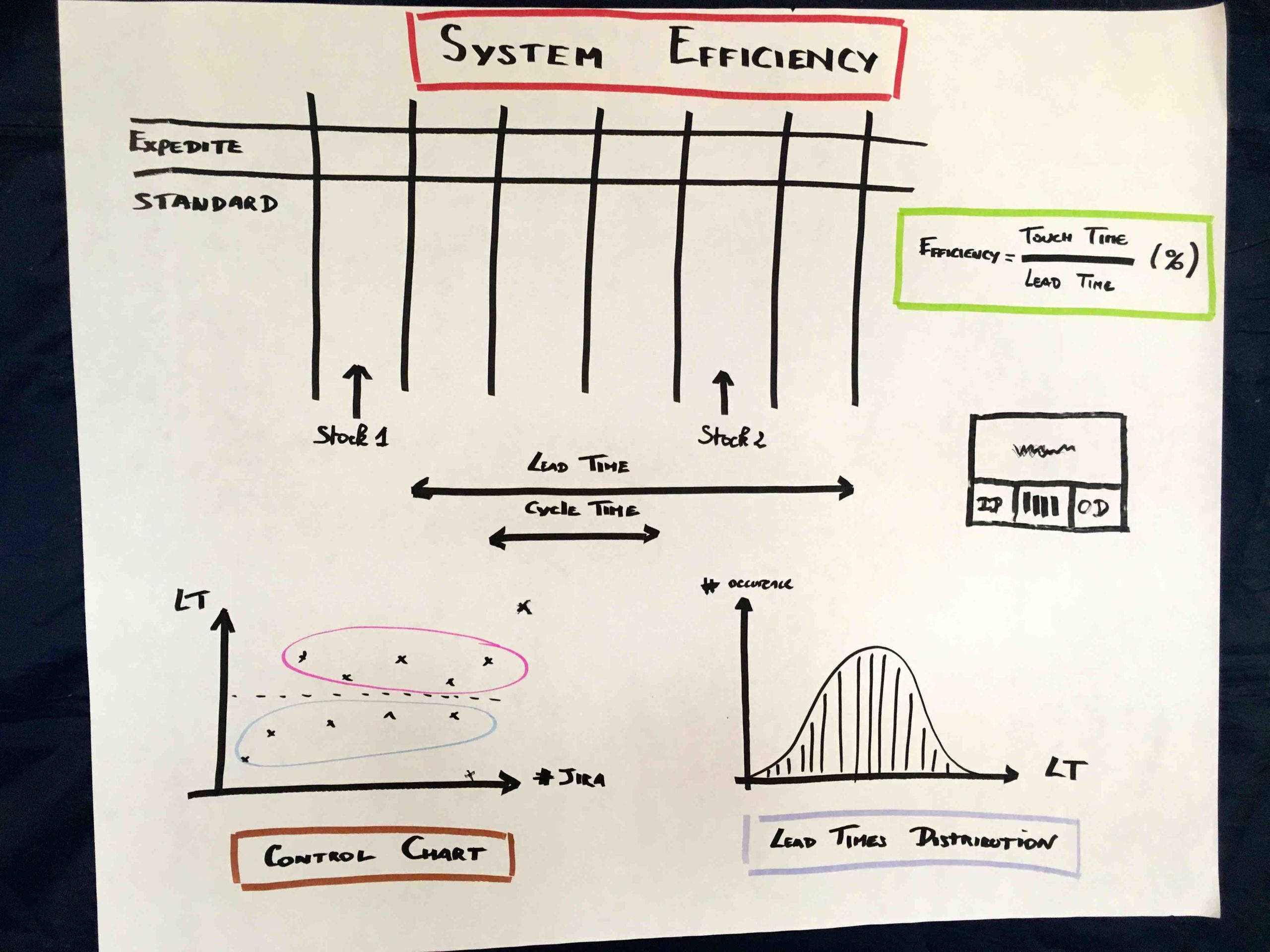
This moment was the theoretical part of the day. A way for participants to be able to rest a little bit! 😉
In addition, the whole team being together, it was a good opportunity to resynchronize everyone's knowledge to go in the same direction.
The topics discussed were: :
- A basic Kanban structure with 2 priority lines : here we see the Expedite and Standard classes of service.
- The notion of dual inventory for the delivery board: the first stock corresponds to all the requests that we have agreed to take into account, resulting from the entire knowledge-discovery phase carried out by the Discovery board. The second stock corresponds to all the requests that are considered ready to be delivered.
- The measures of Lead Time and Cycle Time : time that an element takes from input to output of a system (Lead Time) or a subsystem (Cycle Time).
- There control card : grouping together all the Lead Times of the requests. It makes it possible to observe the difference in processing times and possibly to identify groups of requests as well as their average processing time.
- There distribution of lead times : corresponds to a spectrum of the control chart and makes it possible in particular to be able to obtain a forecast of the system's ability to perform.
- The measurement ofsystem efficiency : structuring number allowing to define the current state of their system. It corresponds to the ratio of Touch Time (time actually spent processing a request) to Lead Time (time between the entry and exit of the request) and thus indicates by inversion the waiting time of a request in the system . If the number is low, then the size of work items can be considered to have less of an impact on processing time than reducing wait times in the system. Also, as a baseline, David J. Anderson mentions that efficiency > 15% is normal and > 40% is good.
The goal is to make the team aware of the elements of measurement, a point often overlooked by many Kanban implementations.
Daily Kanban Meeting
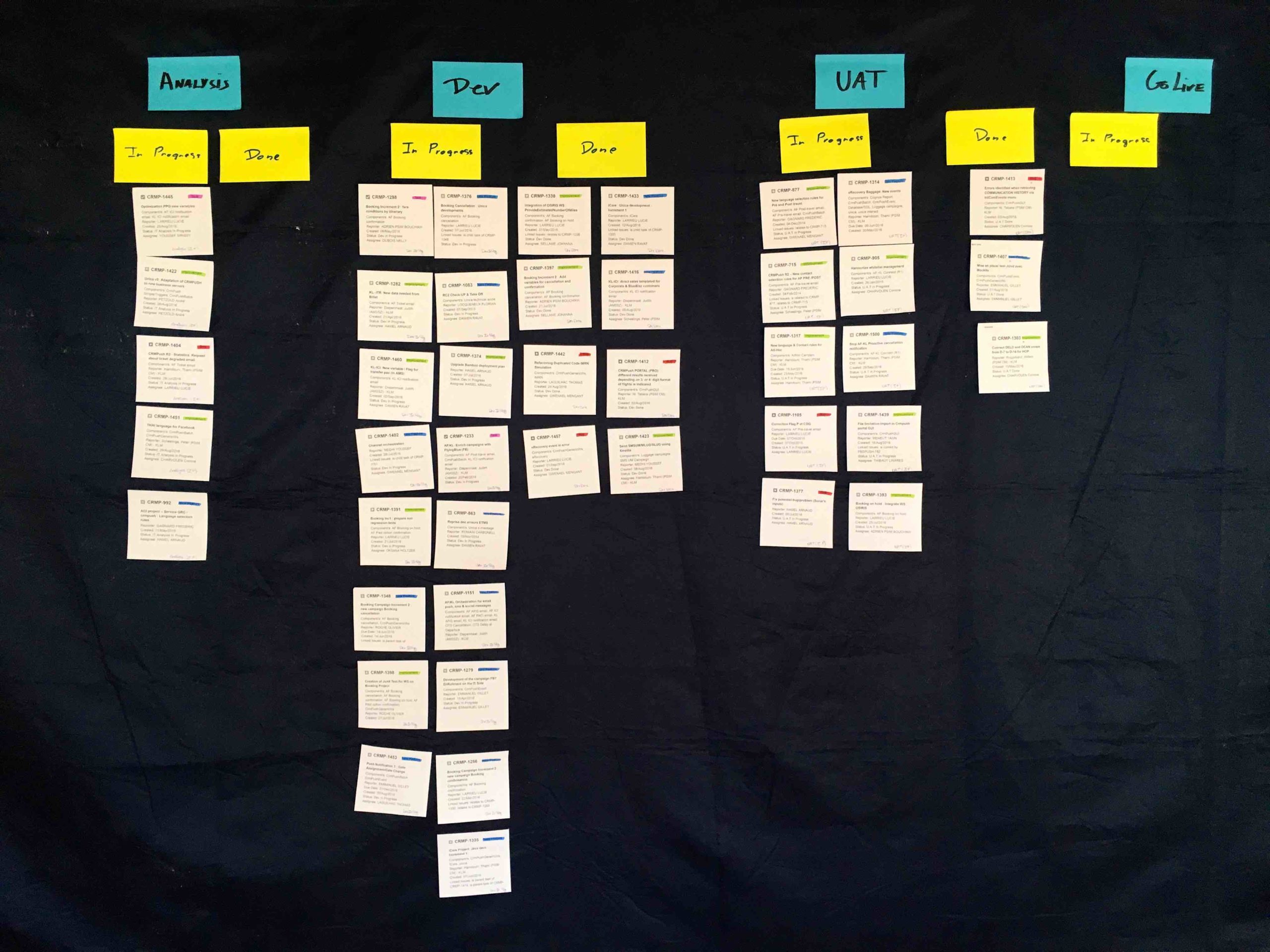
The objective of this part was to simulate a Daily Kanban Meeting with the whole team. Indeed, having all the parties together face-to-face was for me the best configuration to prepare for any future meetings!
Once again, we don't skimp on the means, all the current tickets have been printed and placed on a sticky wall to physically reconstruct what existed digitally.
I then rolled out a typical Daily Meeting Kanban protocol (therefore flow-oriented):
- Is the table up to date?
- Are there urgent elements to go up?
- Are there any blockages to deal with?
- What are you missing to move your work items forward to release?
- Do you need help ?
- Etc…
and all this by browsing the table from right to left! 🙂
Conclusion
This workshop was a very enriching experience for me because I had the opportunity to include people from the team in the organization of the day. We were able to work as a team to develop what seemed to be most relevant to them at that time. My job then was to support them as well as possible and to make the overall program as coherent as possible.
Finally, I am particularly happy to have been able to integrate and lead the “Secret Number” and “Movers and Shapers” workshops that I had wanted to try for a long time. I find them strong in learning and rather simple to animate. I can then warmly recommend them to you! 🙂






